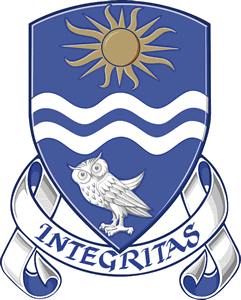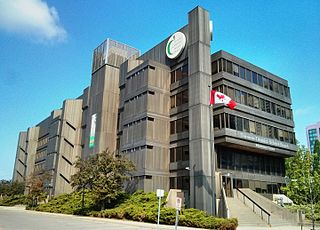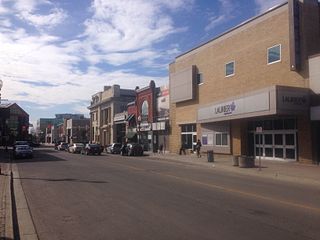The University of Toronto Faculty of Law is the law school of the University of Toronto. Maclean's has consistently assessed the Faculty as the highest ranked common law school in Canada and the highest ranked in terms of faculty journal citations. The Faculty offers the JD, LLM, SJD, MSL, and GPLLM degrees in law.

The University of Toronto Scarborough is a satellite campus of the University of Toronto located in Scarborough district, Toronto, Ontario, Canada.

Nipissing University is a public university located in North Bay, Ontario, Canada. The campus overlooks Lake Nipissing.

Ontario College of Art & Design University, commonly known as OCAD University or OCAD U, is a public art university in Toronto, Ontario, Canada. Its main campus is located within Toronto's Grange Park and Entertainment District neighbourhoods.

The Ontario Veterinary College (OVC) is the oldest veterinary school in Canada. It is located on the campus of the University of Guelph in Guelph, Ontario. The OVC is one of five veterinary schools that offer the Doctor of Veterinary Medicine, DVM program in Canada. The program is highly competitive and only admits a select number of applicants each year. The OVC was ranked 1st in Canada and 5th in the world for veterinary medicine by the QS World University Rankings 2020.

The Ontario Agricultural College (OAC) originated at the agricultural laboratories of the Toronto Normal School, and was officially founded in 1874 as an associate agricultural college of the University of Toronto. Since 1964, it has become affiliated with the University of Guelph, which operates campuses in Guelph and Ridgetown and formerly in Alfred and Kemptville, all in Ontario.

The University of Winnipeg is a public research university in Winnipeg, Manitoba, Canada. It offers undergraduate programs in art, business, economics, education, science and applied health as well as graduate programs. UWinnipeg's founding colleges were Manitoba College and Wesley College, which merged to form United College in 1938. The University of Winnipeg was established in 1967 when United College received its charter.
The Humber College Institute of Technology and Advanced Learning, branded as Humber Polytechnic since 2024, is a public college in Toronto, Ontario, Canada. Founded in 1967, Humber has three main campuses and locations: the Humber North campus, the Lakeshore campus, and the International Graduate School.

Seneca College of Applied Arts and Technology, branded as Seneca Polytechnic since 2023, is a multi-campus public college in the Greater Toronto Area and Peterborough, Ontario, Canada. It offers full-time and part-time programs at the baccalaureate, diploma, certificate, and graduate levels.

Algonquin College of Applied Arts and Technology is a publicly funded English-language college located in Ottawa, Ontario, Canada. The college has three campuses, all in Ontario: a primary campus located in Ottawa, and secondary campuses located in Perth and Pembroke. It offers bachelor's degrees, diplomas, and certificates in a range of disciplines and specialties. The college serves the National Capital Region and the outlying areas of Eastern Ontario, Western Quebec, and Upstate New York. It has been ranked among the Top 50 Research Colleges in Canada and has been recognized as one of Canada's top innovation leaders. The enabling legislation is the Ministry of Training, Colleges and Universities Act. It is a member of Polytechnics Canada.

The Schulich School of Business is the business school of York University located in Toronto, Ontario, Canada. The institution provides undergraduate and graduate degree and diploma programs in business administration, finance, accounting, business analytics, public administration and international business as well as a number of PhD and executive programs. Originally known as the Faculty of Administrative Studies (FAS), it was renamed in 1995 after Seymour Schulich, a major benefactor who has donated $15 million to the school. The Dean of the School, Detlev Zwick, was appointed in 2021 after having served as Interim Dean for 15 months.
The Munk School of Global Affairs and Public Policy at the University of Toronto is an interdisciplinary academic centre. It offers various research and educational programs related to the field of globalization. It is located in Toronto, Ontario, offers master's degrees in global affairs and public policy, and a master's degree in European, Russian and Asia-Pacific studies. This school is a member of the Association of Professional Schools of International Affairs (APSIA). It also works in group of schools that educate students in international affairs. The Munk School's Master of Global Affairs program typically receives 500 and 600 applicants per year and offers 80 students entry into its program.

Education in Toronto is primarily provided publicly and is overseen by Ontario's Ministry of Education. The city is home to a number of elementary, secondary, and post-secondary institutions. In addition to those institutions, the city is also home to several specialty and supplementary schools, which provide schooling for specific crafts or are intended to provide additional educational support.

The University of Guelph is a comprehensive public research university in Guelph, Ontario, Canada. It was established in 1964 after the amalgamation of Ontario Agricultural College (1874), the MacDonald Institute (1903), and the Ontario Veterinary College (1922), and has since grown to an institution of almost 30,000 students and employs 830 full-time faculty as of fall 2019. It offers 94 undergraduate degrees, 48 graduate programs, and 6 associate degrees in many different disciplines.

The University of Ottawa Faculty of Law is the law school at the University of Ottawa, located in Ottawa, Ontario, Canada. Established in 1953, the faculty is today divided into Civil Law and Common Law sections, the two formally recognized legal traditions in Canada.

Laurier Brantford is Wilfrid Laurier University's second campus located in Brantford, Ontario. The first and original campus of Wilfrid Laurier University is located in Waterloo, Ontario. Laurier follows a 'multicampus' structure, as it is one university with multiple campuses.
A bridge program is a partnership in Canada between two post-secondary institutions that allows students to transfer college credits from one institution to another. A bridge program student typically holds a two-year college degree and wants to obtain a four-year or graduate degree.

Toronto Metropolitan University, formerly Ryerson University, is a public research university located in Toronto, Canada. The university's core campus is situated within the Garden District, although it also operates facilities elsewhere in Toronto. The university includes seven academic divisions/faculties: the Faculty of Arts, the Faculty of Community Services, the Faculty of Engineering and Architectural Science, the Faculty of Science, the Creative School, the Lincoln Alexander School of Law, and the Ted Rogers School of Management. Many of these are further organized into smaller departments and schools. The university also provides continuing education services through the G. Raymond Chang School of Continuing Education.

Kaleed Rasheed is a Canadian politician who has represented Mississauga East—Cooksville in the Legislative Assembly of Ontario since 2018. Sitting as an Independent, Rasheed was elected as a member of the Progressive Conservative (PC) Party, however, he left the PC caucus and provincial cabinet on September 20, 2023. He previously served as the minister of public and business service delivery from 2022 to 2023 and associate minister of digital government from 2019 to 2022.
The Université de l’Ontario français is a French-language public university in Toronto, Ontario, Canada. The university campus is situated in the East Bayfront neighbourhood of downtown Toronto, near the Toronto waterfront.

















